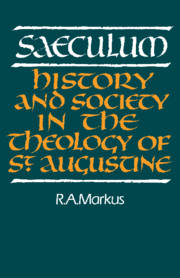Book contents
- Frontmatter
- Contents
- Introduction to the revised edition
- Preface
- Abbreviations
- 1 History: sacred and secular
- 2 Tempora Christiana: Augustine's historical experience
- 3 Civitas terrena: the secularisation of Roman history
- 4 Ordinata est res publica: the foundations of political authority
- 5 Afer scribens Afris: the Church in Augustine and the African tradition
- 6 Coge intrare: the Church and political power
- 7 Civitas peregrina: signposts
- Appendixes
- Bibliographical note
- List of works referred to
- Index
5 - Afer scribens Afris: the Church in Augustine and the African tradition
Published online by Cambridge University Press: 26 October 2009
- Frontmatter
- Contents
- Introduction to the revised edition
- Preface
- Abbreviations
- 1 History: sacred and secular
- 2 Tempora Christiana: Augustine's historical experience
- 3 Civitas terrena: the secularisation of Roman history
- 4 Ordinata est res publica: the foundations of political authority
- 5 Afer scribens Afris: the Church in Augustine and the African tradition
- 6 Coge intrare: the Church and political power
- 7 Civitas peregrina: signposts
- Appendixes
- Bibliographical note
- List of works referred to
- Index
Summary
For Augustine the institutions and the life of politically organised society were irretrievably infected with man's sin. Human society could not heal the dislocation nor bridge the gulf between the ineradicable tensions of this life and the peace of the heavenly city. The depth of this gulf became ever more apparent to Augustine in the course of the Pelagian controversy. Though created good, all men are born in sin; to what we inherit, we add what we do. In sum, the world is evil—but for its redemption by Christ. His coming has created another world, where division is healed, multiplicity restored to unity and corruption to integrity. Humanity has ‘trickled apart’: let us rally, return to oneness, collect what has been scattered, restore what has been broken. The reconciled world is the Church: mundus reconciliatus Ecclesia, as Augustine said in one of his finest sermons on this favourite theme of his. This commonplace of Western theology discloses the richness of its meaning only in the context of Augustine's dialogue with a long history of reflection on the Church in its relation to the ‘world’, especially in Africa.
Augustine belonged to two very different worlds. In Rome and, especially, in the Milan of Ambrose, he encountered a cosmopolitan Church, wielding wide influence over emperors and officials, occupying a place of leadership in society, confident of its power to absorb, mould and transform it. This image of the Church cast a spell over his mind which had some power even after he had come to build his conception of the Church on different foundations. On his return to Africa, however, Augustine encountered an ecclesiology which had become dominated by a very different tradition.
- Type
- Chapter
- Information
- SaeculumHistory and Society in the Theology of St Augustine, pp. 105 - 132Publisher: Cambridge University PressPrint publication year: 1989



